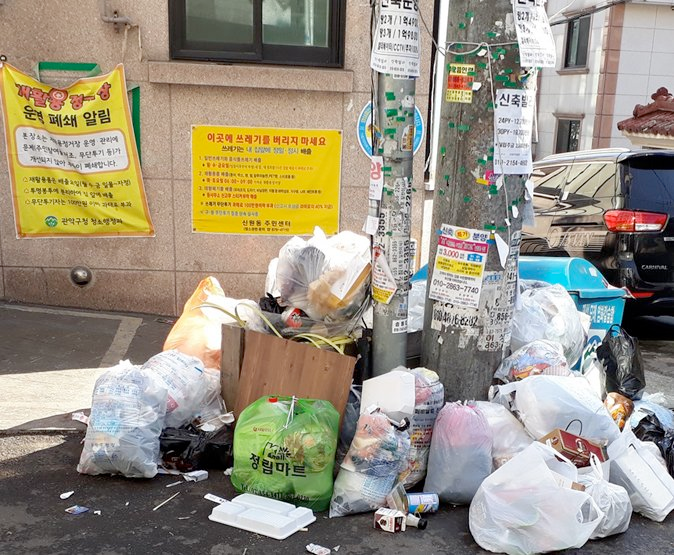If you decide to live off-campus, and especially if you decide to live in your own studio rather than a goshiwon, you will be the one responsible for knowing and following Korean rules for sorting your trash. And even if you don't live on your own, it is good to know the rules of trash sorting.
If you're from the United States, South Korea's trash system can be quite different. South Korea has three main categories for trash: general trash (일반 쓰레기 il-ban sseu-re-gi), recycling (재활용 쓰레기 jae-hwal-yong sseu-re-gi), and food waste (음식물 쓰레기 eum-shik-mool sseu-re-gi). For general trash and food waste, you need to buy special bags to put your trash into, which you can get at pretty much any convenience store. Although, it is best to buy these bags from the convenience store closest to you as these bags are specific to your district and city. And generally, the food waste bags are yellow and the general trash bags are white, but this may differ.

The convenience stores usually have these bags behind the counter, so you will have to ask the cashier to grab them for you. They don't cost that much, only a few dollars. Groceries store also might have them, and sometimes the shopping bags you get when shopping for groceries can double as a general trash bag. They generally have the same symbol on them, but the color may differ.

Here are some key phrases for buying trash bags from the convenience store:
일반 쓰레기 봉투가 있나요? il-ban sseu-re-gi bong-too it-na-yo? (Do you have any general trash bags?)
음식물 쓰레기 봉투가 있나요? eum-shik-mool sseu-re-gi bong-too-ga it-na-yo? (Do you have any food waste bags?)
__리터 주세요. __lee-teo joo-se-yo. (Please give me the __ liter size.)
Note: For general trash, I usually got the 20 liter size (20리터 ee-ship lee-teo), and for food waste I usually got the 3 liter size (3리터 sam li-teo).
__매 주세요. __mae joo-se-yo. (Please give me a pack of__.)
Note: I usually got the 20-pack (20매 ee-ship mae). That much would last me a while, at least a few months.
For recycling, though, you do not need any special bags. If you live in a larger apartment complex, the apartment building might have separate bins for all the different types of recycling (i.e. paper, plastic, glass, cans, cardbord, etc.), so for this you might just need a container in your apartment to store your recycling that you can bring with you to separate directly into the bins. If you live in a smaller apartment complex, like I did, the building might not have a specific trash area with bins, so you will need to buy any kind of trash bag, preferably clear, to put all of your recycling into. For smaller apartment complexes, you will then just place any kind of waste you have directly on the street and the trash collectors will pick it up. Generally everyone in the apartment complex, and sometimes the whole street, will place it in the same place, so when you first move in see where the closest trash pile is to your apartment building and place it there. Generally for this method, learn when trash is picked up in your neighborhood so your trash doesn't start smelling when it's sitting on the street and attracts rodents and scavenger animals, this is especially important for food waste. Pick-up time is usually listed on the bags you buy from the convenience store, but if not, you can find it on your district's website.


.png)
Comments